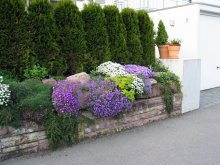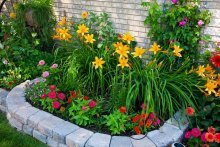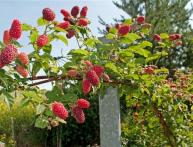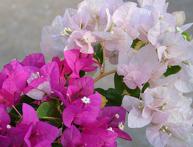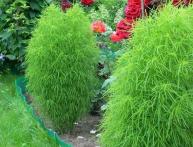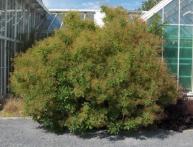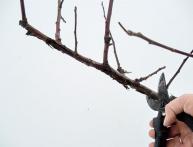What to plant along the fence from shrubs, trees and perennials
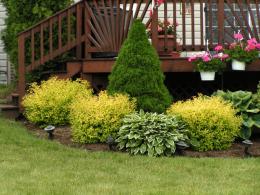
A fence around a local area or summer cottage is a necessary thing. It not only marks the boundaries of the property, but also protects the plantings from visiting the territory by uninvited neighboring pets.
Also, a fence can become an artificial wind protection for many plants. Let's try to figure out what to plant along the fence to make this protective structure look attractive. Plants can be plant both from the inside and outside of the fence.
Content:
- What trees to plant along the fence
- Shrubs for growing along a fence
- Climbing shrubs for planting along the fence
- Flowering perennials for planting along the fence
What trees to plant along the fence
Trees for planting on the outside of the fence
Trees on the outside of the street, in addition to their aesthetic function, act as a kind of filter that traps street dust and exhaust gases. For the outside of the fence, trees that can withstand pruning well and are not too valuable or rare are suitable, this will help avoid vandalism. In addition, you need to choose plants that are unpretentious and resistant to frost, drought and other unfavorable conditions. The following are most suitable for these purposes:
- small-leaved elm
- common elm
- Rowan
- river maple
- Tatarian maple
Common elm
In the wild, the common elm is distributed almost everywhere in deciduous forests.It is found in the European part, in Siberia, the Caucasus, and the Baltic states. In Kazakhstan. The tree grows up to 25 meters in height. The plant is shade-tolerant and drought-resistant.
Elm has been used in landscaping for a very long time, due to the fact that it not only tolerates shearing well, but also holds its given shape well. Has many decorative forms:
- silver-motley
- golden-variegated
- red

To the disadvantages of elm landings demands on the fertility of the land can be attributed. On poor soils, the growth of these trees slows down. In addition, elms can attract unwanted pests and be actively damaged by them. An undoubted advantage is that the common elm lives for a very long time, up to 200-300 years.
Conifers for the inside of the fence
On the inside of the fence, you can plant primarily coniferous trees with slow growth and with decorative needles and crown. In addition to being decorative, coniferous trees purify the air and emit phytoncides that are beneficial to health. In the summer, bright annual flowers can be planted near the plantings to create a contrast with the dark needles.
Suitable for planting near the fence on the inside:
- low-growing species of prickly spruce
- medium-sized species of common spruce
- decorative types of spruce
Norway spruce Acrocona
This species grows no more than 8 cm per year, an adult plant is no more than 3.0 m in height. The crown is conical, with a wide base up to 4.0 m. needles of rich green color. Young pink cones make the trees elegant and attractive. This species does not tolerate dry soils with high salinity.
In addition to spruce trees, low-growing thujas can be grown along the fence, pine trees, larches.Despite the variety of species and varieties of coniferous and deciduous trees, most property owners when decorating fences give preference to unpretentious shrubs.
Shrubs for growing along a fence
The choice of shrubs for growing along the fence is very large. Among them you can choose species with a long flowering period, fruit-bearing, and prickly ones. Along the fence you can plant:
- irgu
- barberry
- spirea
- chokeberry
- Kuril tea
- lilac
- decorative cherries
- rose hip
- Barberry
It is very convenient to plant decorative types of barberry along the fence; this shrub is unpretentious, tolerates any pruning well, and has thorny branches, which serve as additional protection from unwanted visitors. Among all barberries, decorative varieties can be distinguished barberry Thunberg.
Barberry Thunberg purple-leaved
This deciduous shrub is moderate in size, up to 1.5 meters. The shrub has flexible, arched shoots. It features beautiful, purple foliage in early summer. The flowers are bright yellow, collected in racemes. The flowers have a very pleasant aroma.
The berries are red and stay on the bushes for a long time. This keeps barberry attractive as winter approaches. During the growing season, the dark purple leaves gradually become colored with spots of yellow, orange, and green. The plant is unpretentious to soil composition, winter-hardy and drought-resistant. Thanks to its long, up to 1 cm, thorns it creates impenetrable thickets.
Sand cherry
This type of decorative cherries is attractive throughout the season. In spring, large, about 1.8 cm in diameter, white flowers appear on reddish shoots. They are very fragrant, collected in bunches of three flowers.The height of mature plants is about 1.5 m.
In place of the flowers, completely edible black-purple fruits are formed. The leaves become orange-red in autumn. Can be planted along the fence in combination with spruce trees. It grows very quickly, undemanding to watering and soil composition. In recent years, the plant has been gaining popularity due to its decorative qualities.
In addition to trees and shrubs, along the fence you can plant various climbing and creeping plants.
Climbing shrubs for planting along the fence
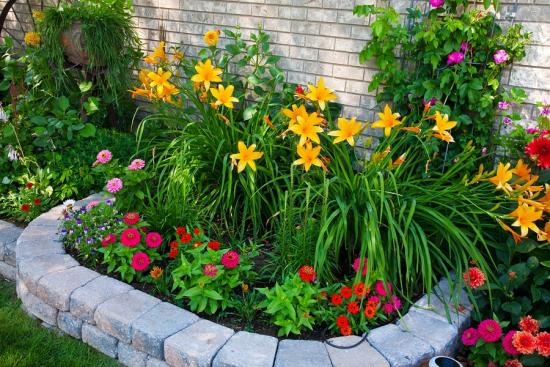
Climbing plants can be an excellent decoration for a fence both inside and outside. Along the fence you can plant:
- honeysuckle honeysuckle
- hop
- girl's grapes
- clematis
- actinidia
Honeysuckle Honeysuckle
In the wild, it is distributed in the middle and southern regions of Europe and the Caucasus. In ornamental gardening, it is valued for its fast growth and charming appearance throughout the season. The climbing shoots grow up to 3-5 m in height. During the season, young shoots can lengthen by 0.8 m. In good sunlight they have a red-violet color.
The leaves are oval, dense, leathery. The upper part of the leaf blades is dark, green, the lower part is gray. The leaves last a very long time in the fall, while retaining their color. At about the 4th year the plant blooms. Flowers of an original shape, with protruding stamens.
The flowers are white or yellow inside, with a soft purple color on top. Up to 5 cm long, from a distance they look like moths with raised wings. The flowering period is 20 - 25 days.
Inedible orange fruits appear in place of the flowers. The plant requires the formation of bushes. To do this, it is evenly planted along the fence. To create support, strings are pulled.To prevent the plant from turning into tangled thickets, it is trimmed in a timely manner both on top and on the sides.
Neglected bushes are pruned close to the ground, after which the dormant buds will give rise to new shoots. Honeysuckle honeysuckle does not suffer from diseases.
Actinidia kolomikta
In the wild, this plant grows as a vine in the forests of the Far East. Of all the types of actinidia, it is distinguished by the decorative color of its foliage. At the beginning of spring they are bronze in color, after which they become green; at the end of flowering, the ends of the leaf blades turn white, after flowering the leaves become crimson.
In autumn, the foliage takes on the most bizarre shades from purple to yellow. The flowers are white, with an unusually pleasant smell, which can be felt at a fairly large distance. The fruits are edible, the plant itself is a relative of kiwi. Quite unpretentious, a special feature of care is shallow loosening of the soil. In addition to shrubs and trees, perennials can be planted along the fence.
Flowering perennials for planting along the fence
Perennial herbaceous plants can become a beautiful and unpretentious decoration for a fence. Sufficiently tall flowers are suitable for this:
- delphinium
- stock-rose
- rudbeckia
- goldenrod
- lupine
Rose stock
This plant has a second name - mallow. It is distinguished by a fairly high, up to 2 m, stem and bright flowers of various shades. Depending on the type, mallow has flowers of white, pink, red and dark cherry color. Flowers can be either simple or double, up to 12 cm in size.
Flowering is long-lasting, beginning in early July and continuing until the end of September. The leaves are large, up to 10 cm, with serrated edges. Most often, the plant does not require special care, however.Mallow grows poorly in very poor, heavy and overly moist places.
The choice of plants for growing along the fence is very large; here everyone can choose plants in accordance with individual preferences.
Video about what plants to choose for a hedge:

